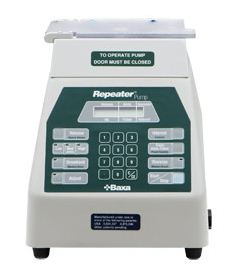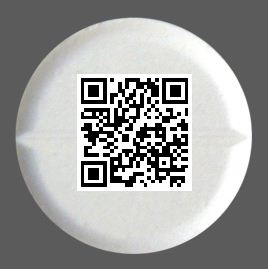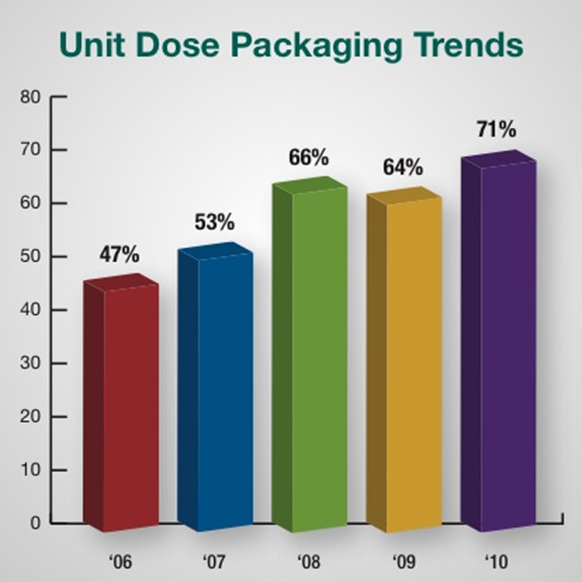 The Baxa Repeater Pump is a pretty cool piece of pharmacy technology. The device automates many of the repetitive processes used in filling oral syringes, oral dosage cups, syringes used for injection and reconstituting medications used to mix intravenous medications in the acute care setting. I remember working in a pediatric facility and watching the technicians fill thousands of oral syringes with liquid acetaminophen and ibuprofen for use in automated dispensing cabinets throughout the hospital. With the use of the Syringe Filling Fixture, and the automated pump setting on the Repeater Pump, the technicians could fill a phenomenal number of syringes in a very short period of time. Other times the technicians used the foot pedal on the Repeater Pump in order to control the rate at which the process moved; art in motion. Either way it was a bummer when they were finished as I had to check all those syringes. Regardless, the pump was a valuable piece of equipment when repetitive fluid transfer was required.
The Baxa Repeater Pump is a pretty cool piece of pharmacy technology. The device automates many of the repetitive processes used in filling oral syringes, oral dosage cups, syringes used for injection and reconstituting medications used to mix intravenous medications in the acute care setting. I remember working in a pediatric facility and watching the technicians fill thousands of oral syringes with liquid acetaminophen and ibuprofen for use in automated dispensing cabinets throughout the hospital. With the use of the Syringe Filling Fixture, and the automated pump setting on the Repeater Pump, the technicians could fill a phenomenal number of syringes in a very short period of time. Other times the technicians used the foot pedal on the Repeater Pump in order to control the rate at which the process moved; art in motion. Either way it was a bummer when they were finished as I had to check all those syringes. Regardless, the pump was a valuable piece of equipment when repetitive fluid transfer was required.
(more…)
Author: Jerry Fahrni
-
Cool Technology for Pharmacy – Baxa Repeater Pump
-
Don’t dismiss the value of an operationally sound pharmacist
As pharmacists begin to move out of the physical pharmacy to the patient bedside I think it will become important not to forget the value of a pharmacist that is well versed in how to handle the operational side of pharmacy. Don’t get me wrong, I think pharmacists should be used more for therapeutics than for the role of physically dispensing medications. However, consider a practice model for pharmacy where technicians are more involved with the day to day operations and automation plays a bigger role in the dispensing process. In this instance a pharmacist will be needed for technician oversight as well as to control the workflow of the pharmacy. In addition that pharmacist will need to have intimate working knowledge of the automation and technology used in the pharmacy space. I don’t believe that a pharmacist needs to see every single item dispensed from the pharmacy, but I do think global oversight is necessary. There are opportunities for positive interventions in all aspects of acute care pharmacy practice.
I began my career as a “operational specialist”. The hospital where I was employed used a hybrid model of satellites and centralized dispensing. They needed stability in the dispensing area secondary to the pharmacist shortage. The pharmacy manager came to me and offered me a unique opportunity to handle the workflow in the main pharmacy from an operational standpoint. The hours were’t great, working Monday through Friday from 1:30pm until midnight, but it gave me a chance to try something new. I spent about a year in this role and found great value in the lessons learned through trying variations on the age old themes of cart fills, ADC replenishment, IV batches, etc. It was worth it.
Do I see the need for an operational specialist in acute care pharmacy? Perhaps, but not in the traditional sense. I see the need for a pharmacist trained in automation and technology with additional skills to manage people and workflow. After all, it is still important that patients receive their medications as safely and efficiently as possible. I envision a role similar to the one I’m in now, with the only difference being less focus on the clinical application of technology for a more mechanical one. Most informatics pharmacists handle both areas of technology now, but as clinical decision support, rules engines, computerized provider order entry, and so on become more prevalent it may become necessary to split the jobs into separate specialties; clinical pharmacy software and pharmacy automation and technology. There’s plenty going on in pharmacy informatics to justify such a design. Similar to pharmacists that have chosen to specialize in Cardiology or Infectious Disease, I think we’re headed for a time when informatics pharmacists will begin to tease out specialized roles in healthcare information technology.
Just a thought.
-
Imprivata OneSign Secure Walk-Away Technology
While at Innovations a couple of weeks back I stumbled across the Imprivata booth at the vendor expo. There were quite a few people gathered around the booth so I obliged my curiosity and squeezed in among the crowd. The Imprivata representatives were giving a demonstration of the company’s OneSign 4.5 application with Walk-Away technology. There must be something compelling about the Imprivata line of products as I found myself blogging about their OneSign Platform about this time last year.
The Walk-Away technology was impressive. As long as a user was standing in front of the computer camera they remained logged in. However, as soon as the user turned to walk away they were immediately logged out of their session. This is a significant step forward in managing those unattended workstations that one often finds throughout the hospital.
From the Imprivata website: “OneSign Secure Walk-Away closes a critical security gap in the protection of confidential information assets by automating the process of securing the desktop when a user ‘walks away’. Once a user has securely authenticated to the desktop using OneSign Authentication Management, OneSign Secure Walk-Away uses a combination of computer vision, active presence detection, and user tracking technologies to identify an authenticated user and automatically lock the desktop upon their departure.â€
You can read more about the system here (PDF). Try as I might I could not find a video demonstration of the Walk-Away system; too bad really as the system has to be seen to be appreciated. I’m not a big fan of single sign-on systems (SSO) in general for various reasons, but I’m willing to reconsider my position when SSO is used in combination with biometric identification, voice recognition or facial recognition technology. It’s just too cool to ignore.
-
Top blog posts and searches from last week (34)
I always find it interesting to see what brings people to my website and what they decided to read once they get here.
Most read posts over the past 7 days:
- Automated unit-dose packagers for acute care pharmacy
- Best iPhone / iPod Touch Applications for Pharmacists
- Cool Technology for Pharmacy (June 18,2009 – Alaris Smartpumps)
- Unforeseen barrier to tech-check-tech endeavor
- It may be time to consider robotic IV preparation at the bedside
- Musings on the “cloudâ€
- Is the 30-minute rule for medication administration good or bad?
- Using the concept of the iPad to further pharmacy education
- Moving storage around in the “cloudâ€
- Barcodes on patient wristbands
Top searchterm phrases used over the past 7 days:
- “alaris pumpâ€
- “transparency â€
- “black cloudâ€
- “cloud computing cartoonâ€
- “alaris iv pumpsâ€
- “robot rx“
- “pharmacy informatics
- “example admitting order“
- “ipod applications, pharmacist“
- “patient wristbands“
-
Lots of Interest for the Samsung Galaxy Tablet
A small video showcasing some of the features of the Samsung Galaxy Tablet made its way around the internet this week. The slate tablet includes a 7 inch screen, Android 2.2, video calling – which I think will become more important as we move forward in healthcare – plus other features. The device is scheduled to make its official appearance on September 2, 2010 at the IFA in Berlin, Germany. Boy, would I like to attend that event.
.
.
I like the look of the device, but only official reviews will tell me if the it’s any good. I’m concerned that the 7 inch screen might be too small, but this is consistent with recent tablet designs like the Cisco Cius and rumors of a new 7 inch Apple iPad. For me it makes more sense to design a tablet about the size of a standard legal pad, but there must be something to this 7 inch design as I assume manufacturers don’t waste their time and money on baseless design. I would really like to get my hands on this device.
-
Unforeseen barrier to tech-check-tech endeavor
I’ve been on a mission, however small it may be, to get pharmacy technicians more involved in the operational aspect of acute care pharmacy. And by more involved I mean using a tech-check-tech model to free pharmacists up for more patient related clinical activities. I’ve posted my thoughts on the use of tech-check-tech before.
The reason for rehashing the issue is due to a conversation I had with a colleague last week. This particular colleague and I were having a light hearted discussion over the possibility of using a tech-check-tech model with automated packagers like those I described in a post earlier this week.
(more…) -
Top blog posts and searches from last week (33)
I always find it interesting to see what brings people to my website and what they decided to read once they get here.
Most read posts over the past 7 days:
- It may be time to consider robotic IV preparation at the bedside
- Cool Technology for Pharmacy (June 18,2009 – Alaris Smartpumps)
- Best iPhone / iPod Touch Applications for Pharmacists
- Update: Siemens Innovations 2010 final day
- Musings on the “cloudâ€
- Update: Siemens Innovations 2010 parting thoughts
- Is the 30-minute rule for medication administration good or bad?
- Musings on poor resource management in healthcare
- About
- Moving storage around in the “cloudâ€
Top searchterm phrases used over the past 7 days:
- “black cloudâ€
- “transparency â€
- “medication reconciliationâ€
- “cloud computing cartoonâ€
- “cool pharmacyâ€
- “capsule machineâ€
- “alaris iv pumpsâ€
- “lxe 8650 + “ipad†–ipodâ€
- “medscape mobileâ€
- “alaris pumpâ€
-
“What’d I miss?” – Week of August 15, 2010
As usual there were a lot of things that happened during the week, and not all of it was pharmacy or technology related. Here’s a quick look at some of the stuff I found interesting.
(more…)

